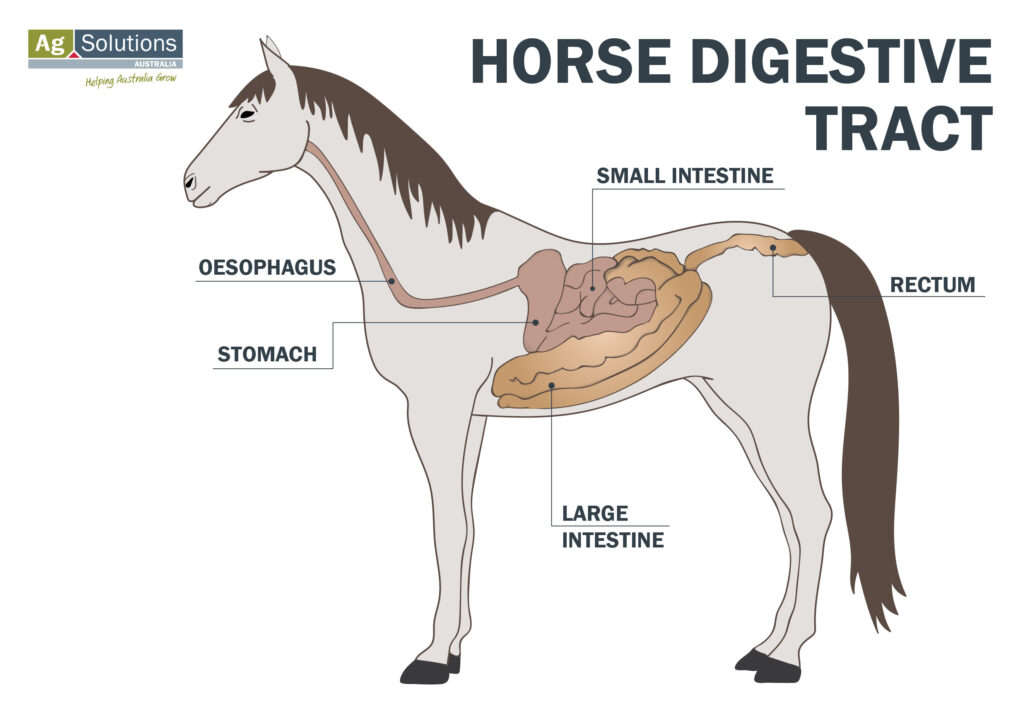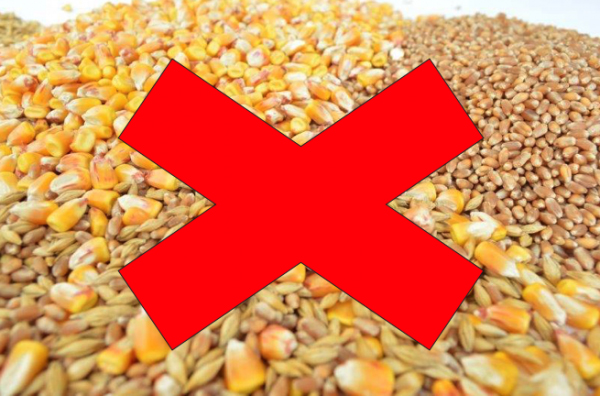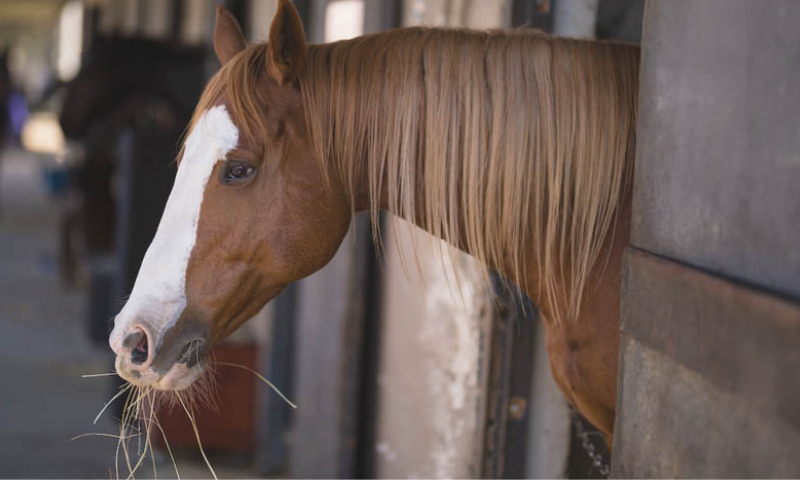Horses are what we call monogastric (single stomach) hindgut fermenters and their digestive tract has been designed for eating high fibre forages over long periods of the day.
However, horses don’t have the necessary enzymes to digest fibre by themselves and this is where the trillions of gut bacteria help out in what we call a symbiotic relationship. It is the bacteria in the hindgut that ferment fibre which produces volatile fatty acids that the horse then uses to meet a large portion of its daily calorie requirements. In addition to providing horses with volatile fatty acids the bacteria also provide essential vitamins such as biotin, B-group vitamins and vitamin K.

Gut Bacteria
A fun fact to keep in mind is that there are more bacteria cells in your horse’s body than what there are equine cells! Therefore, whenever we feed our horse’s we need to consider whether the food will be beneficial to the gut microbes or whether it could have a negative impact. There are three major groups of bacteria in the hindgut comprising of fibre fermenters (the good guys that we want lots of), starch and sugar fermenters (we don’t want too many of these guys) and the lactate utilising bacteria (these guys are like the security staff that help keep the starch and sugar guys under control).
If the majority of your horse’s diet consists of (low sugar) grass, hay and/or chaff then the fibre fermenting bacteria will be receiving lots of their favourite food. If large amounts of sugar (some “improved” pastures contain high amounts of fermentable sugars such as fructan) and starch (cereal grains contain a lot of starch) are delivered to the hindgut than the starch and sugar fermenting bacteria will rapidly increase in numbers as they are happily fermenting their favourite food and producing lactic acid. The more lactic acid that is produced, the more the pH will be lowered in the hindgut and unfortunately our friendly fibre fermenting bacteria don’t like acidic environments and will begin to die off.
When there is more lactic acid around, the lactic utilising bacteria now have access to their favourite food and will start to increase in numbers. These guys are really helpful as they will take the lactic acid which the horse can’t use and convert it to volatile fatty acids which the horse can use for energy. Unfortunately, sometimes there is just so much sugar and starch being fermented and consequently so much lactic acid being produced that the lactic acid fermenters can’t multiply quickly enough to prevent a catastrophic accumulation of lactic acid in the hindgut.
If the gut microbial balance is affected this can have a detrimental result on your horse as it could end up with:
- Laminitis,
- Hindgut acidosis,
- Colic,
- Endotoxaemia,
- Loss of appetite and weight loss,
- Vitamin deficiencies ,
- Behavioural changes,
- Poor feed efficiency,
- Slow growing and weak hooves.
How To Help Keep The Hindgut Bacteria Healthy?
As horses are grazing animals, the number one thing to remember is they need to be fed lots of fibre. It has been established that horses need an absolute minimum of 1.5% of their body weight each day in forage just to maintain gut health. So, a great way to keep the hindgut healthy is by providing unlimited access to low sugar pasture, hay and/or chaff.
Remember lots of sugars in the diet can lead to rapidly increasing populations of sugar and starch fermenting bacteria and this is what we want to avoid happening. So, if your horses are grazing improved pastures such as ryegrass or have any metabolic issues (laminitis) then it is best to only let them graze in the early hours of the morning and bring them off the pasture by two hours after sunrise. This is because plants make their own food during a process called photosynthesis (which requires sunlight) and consequently sugars and starch are at the highest levels during daylight hours and at the lowest levels in the very early hours of the morning. Don’t forget to provide low sugar hay (preferably in a slow feeder hay net) when horses are off pasture as it is vitally important that their stomach is not empty for too long, read How To Reduce The Risk Of Your Horse Developing Gastric Ulcers for more information.
So, we know that diets consisting of lots of forage is best for a healthy hindgut. However, some horses require more calories than what they can obtain from forage alone. To help increase calorie content of the diet start by adding fibre based, low starch feeds where possible. These kinds of feeds are filled with high energy “super” fibres like soybean hulls, beet pulp and lupin hulls that are happily fermented in the hindgut by the fibre fermenting bacteria. Incorporating oil into the diet is also a great way to add extra calories but once again you need to consider the bacteria and they need time to adjust to a diet full of oil.

Now, I do want to say that it is okay to feed grain – with conditions! The number one condition is to only feed cooked grain (if you truly have no other option other than raw grain then choose oats as the horse is able to digest a large portion of the starch found in oats in the small intestine). When raw grains are fed to horses, only a small proportion (usually <30%) of the starch is digested in the small intestine with the rest passing through to the hindgut. When comparing methods of processing of corn, Richards (2003) found that the percentage of starch digested in 15 minutes were as follows:
- Raw corn 14%
- Micronised corn 33%
- Extruded corn 73%
Another couple of rules when adding grain to your horse’s diet is to introduce grain into the diet slowly, and gradually build up the quantity being fed over a couple of weeks (in fact all dietary changes should be made slowly). This will allow the enzymes in the small intestine time to adapt to digesting starch. Most importantly, only feed small amounts of grain at a time (a maximum of 2kg in one meal) and preferably no more than 4kg in one day.
Sand colic has been a huge issue in the drought affected areas of Australia in recent months, and a way that you can help remove sand and dirt from the hindgut of your horse is by feeding psyllium husk on a regular basis. It is recommended that 50 grams of psyllium husk is fed per 100 kg of bodyweight for 5 days of each month.
Including a prebiotic (MegaMin Equine Enhancer contains a prebiotic) can also be beneficial for gut health with research supporting improvements in feed digestibility and efficiency by promoting a healthy balance of bacteria. Prebiotics are essentially food for the bacteria living in your horse’s digestive tract and promote the health and growth of these microorganisms.
Whatever you do, don’t forget to ensure that your horse has unlimited access to fresh, clean drinking water. Water is absolutely crucial for maintaining a healthy hindgut and if dehydration occurs the contents of the hindgut will dry out too much and can result in issues like impaction colic.
In conclusion, whenever we feed our horses we have to stop and think of the hindgut and whether or not what we are giving them is good for the microbial populations that reside there.
By Shannon Godwin BAppSc GDTL
